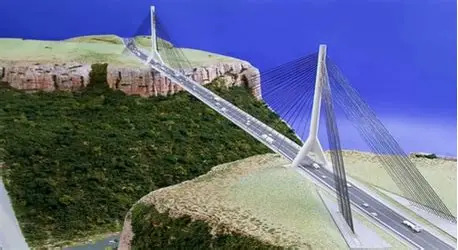The Msikaba Bridge, under construction in South Africa’s Eastern Cape, represents a landmark in modern steel bridge engineering. The bridge spans the deep Msikaba River gorge and forms a vital part of the N2 Wild Coast Road project – an initiative to improve freight mobility and regional connectivity in challenging terrain. Designed by Dissing+Weitling and engineered by SMEC South Africa, this R1.65 billion structure showcases cutting-edge steel applications that address structural complexity, environmental sensitivity, and long-span demands.
Spanning 580 m with a main span of 580 m and a deck height of 194 m above the riverbed, Msikaba is the second-longest cable-stayed bridge in Africa. Its superstructure comprises an orthotropic steel deck-a lightweight yet high-stiffness system using flat steel plates stiffened by longitudinal and transverse ribs. This configuration significantly reduces self-weight, allowing for longer spans with fewer piers, thereby preserving the natural ecosystem below.
The bridge features two towering 127 m high concrete pylons anchored by steel stay cable systems, connected to prefabricated steel box girder segments forming the deck. These segments were fabricated off-site in precision-controlled environments and transported via land and river routes to the construction site. High-performance structural steel was chosen for its strength-to-weight ratio, corrosion resistance, and ability to withstand dynamic forces such as wind, traffic load, and seismic activity.
Msikaba’s construction methodology emphasises prefabrication, modular steel assembly, and precision lifting, including the use of hydraulic strand jacks for positioning steel deck modules at significant heights. The integration of steel into cable anchors, deck ribs, and pylon linkages ensures structural integrity while maintaining an elegant, streamlined aesthetic suited to its natural setting.
Beyond engineering, the bridge holds cultural and environmental significance. By minimising the number of grounds supports and using steel for long-span reach and durability, the design protects the surrounding flora and fauna. Msikaba Bridge exemplifies how advanced steel technologies can redefine infrastructure-merging functionality, sustainability, and architectural form in one of Africa’s most ambitious transport projects.




